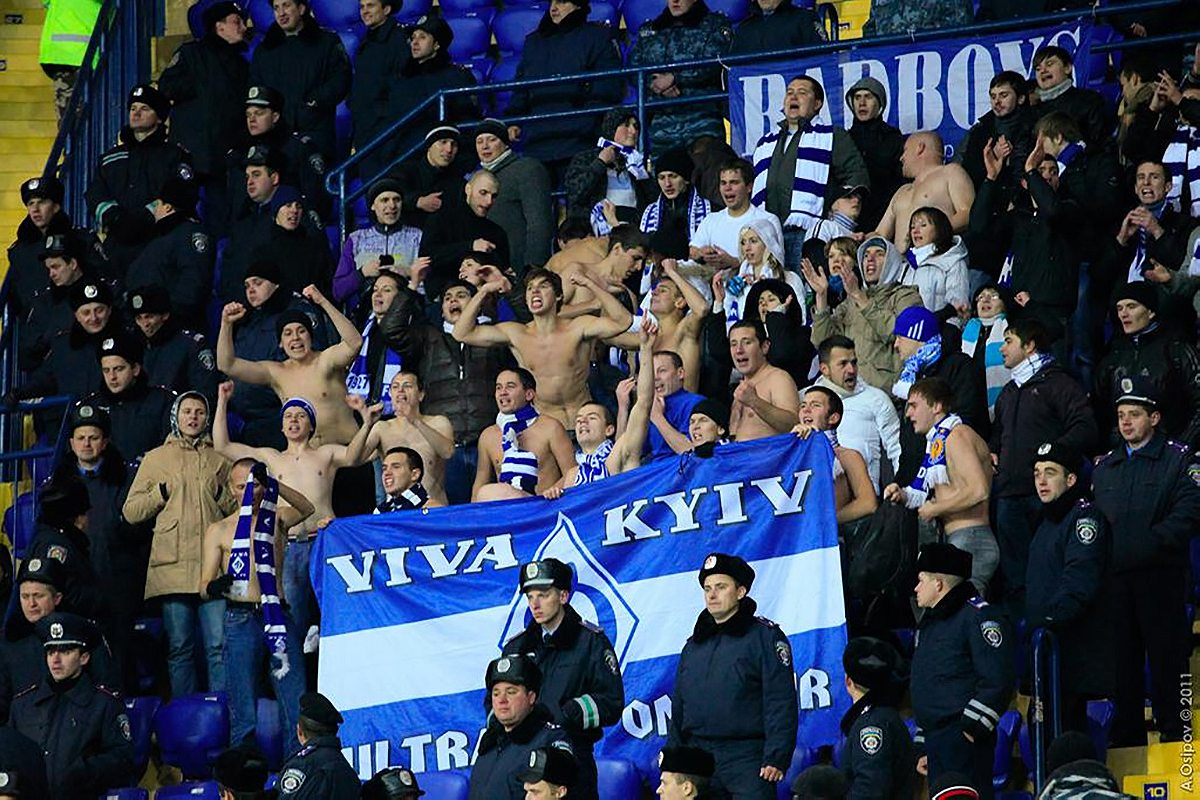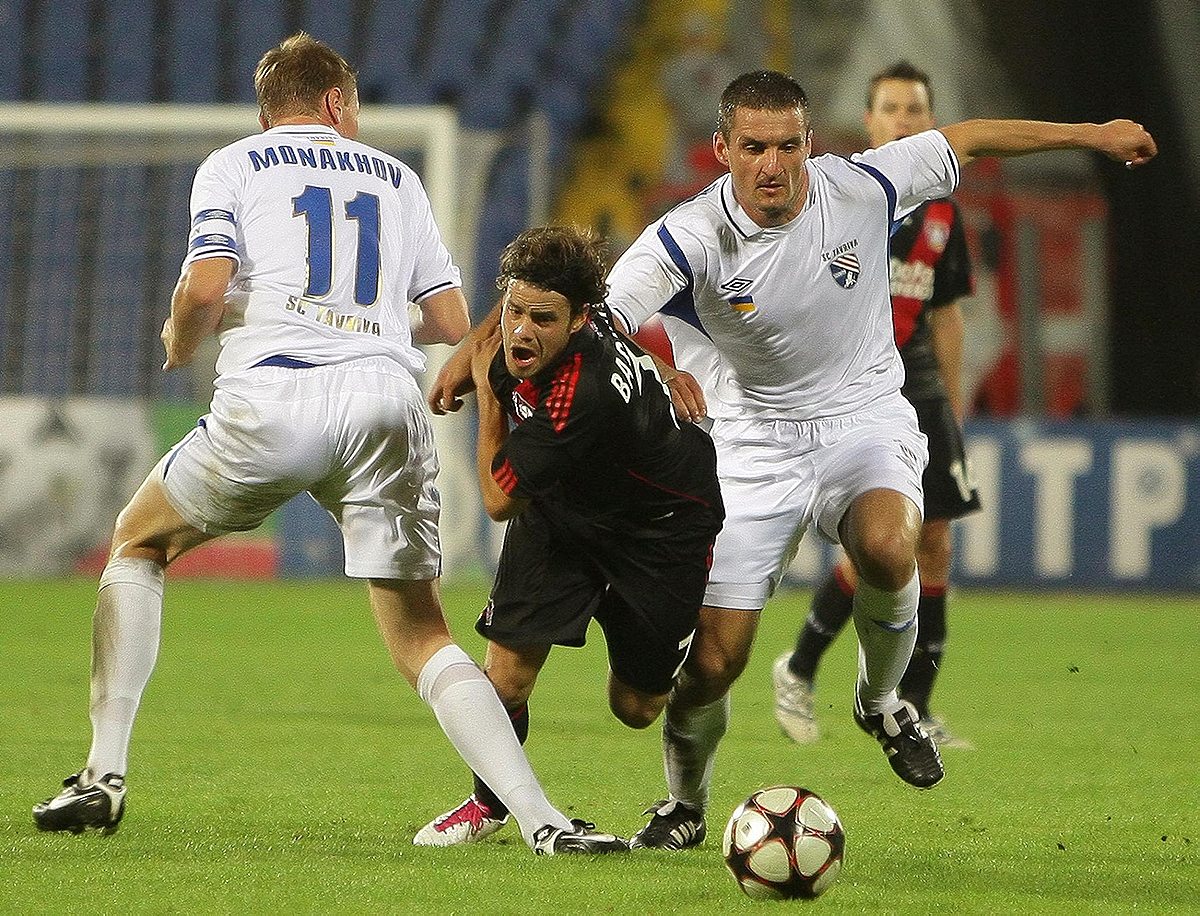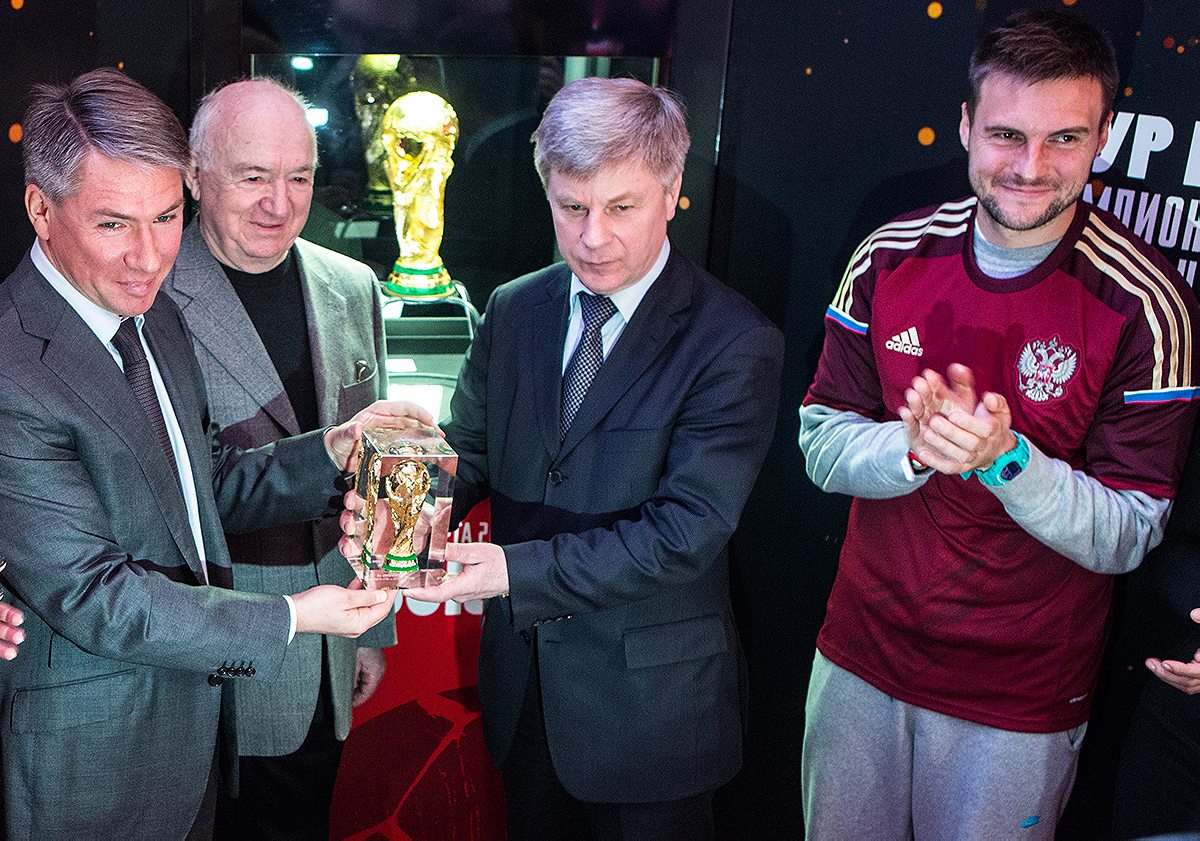The future of Crimea is uncertain, and so is the future of its two most storied and successful football clubs.
In 1992, Tavriya Simferopol made history when they became the first ever champions of independent Ukraine. The country had emerged a year before from the disintegration of the Soviet Union, a process that demanded not only the restructuring of borders, armies, and civil services, but also of national football leagues. Tavriya, from Crimea, beat Dynamo Kyiv, the giant club from the capital, in the final to win Ukraine’s inaugural competition.
That victory may be the first and last time a club from Crimea ever achieves that feat. Two Sundays ago on March 16, while Tavriya was losing to Dynamo Kyiv, a referendum held in Crimea returned a 96.77% vote in favor of uniting the territory with the Russian Federation.
As if on cue, the Russian Football Union (RFU) has also announced its intention to incorporate the two major Crimean clubs. “In the near future, at working meetings we will prepare a project of the relevant documents” needed to absorb the two clubs, said RFU President Nikolai Tolstykh. “We will hold consultations with FIFA and UEFA, and with the Ukrainian Football Federation.” It looks as though Ukraine’s first national champions may no longer play in Ukraine.
Tavriya remain one of only three teams to win the Ukrainian Premier League, in the esteemed company of Dynamo Kyiv and Shakhtar Donetsk. Despite this history, their recent form remains worrying. Current manager Nikolay Kostov has been unable to arrest their fall into the lower reaches of the league, with attendances at the nearly 20,000-capacity Lokomotiv Stadium waning.
Away from the pitch, financial struggles also threaten the club’s existence. Tavriya’s main financial backer Dmytro Firtash—a titanium magnate whose rise has been closely linked to the now-ousted, pro-Russian President Viktor Yanukovych—was arrested in Austria on suspicion of bribery before posting the largest bail in Austrian history last week. He says the charges, which come after a long FBI investigation, are politically motivated. Either way, the drama has led to speculation about his future willingness to pay the wages and transfer fees of his team, the Krymchyany (Crimeans).
At stake are the two crown jewels of Crimean soccer
On the pitch at least, FK Sevastopol are on a different trajectory than their neighbors in Simferopol. The club was only founded in 2002, the self-proclaimed “spiritual successor” of previously failed Sevastopol clubs. They found their competitive feet in the Ukrainian third tier, eventually climbing to the second tier in 2007, before reaching the holy grail of the Ukrainian Premier League for the first time in the 2010/11 season. Since then, the club have yo-yoed in and out of the top division, but now sit comfortably in mid-table in the Premier League.
Sevastopol’s success, like Tavriya’s decline, was facilitated by the fortunes of a major financial backer with close ties to Yanukovych. Vadim Novinsky, a native of Russia and a metallurgy billionaire, was awarded Ukrainian citizenship by Yanukovych before winning a 2013 Sevastopol by-election as an independent, then joining the Party of Regions (headed by none other than Yanukovych). Owning a successful soccer club in Ukraine has always been a way to build political support and influence, as illustrated emphatically by Rinat Akhmetov at Shakhtar. Akhmetov first became president of FC Shakhtar after a 1995 bomb attack in the stadium killed his mentor and predecessor. He has since become one of the wealthiest men in the world, intimately connected to Yanukovych’s former political party.
But if key soccer oligarchs are stacked in Yanukovych’s camp, soccer supporters across Ukraine have been involved on both sides of the Maidan uprising and the subsequent Crimean crisis. During the tumult in Kyiv, “ultras” guarded the protestors, protecting them from the pro-government muscle, the Titushky. Dynamo Kyiv’s ultras pushed for a truce between the ultras of Ukraine’s varied and often antagonistic clubs, supported by the ultras of Tavriya and Sevastopol. “We have decided to conclude a truce between the movements of fans of different clubs indefinitely,” the statement read.
Owning a successful soccer club in Ukraine has always been a way to build political support and influence
The actions of the ultras of both Tavriya and Sevastopol belie the common wisdom about the political leanings of people in heavily ethnic Russian Crimea. Tavriya’s ultras in particular supported Maidan protestors in large numbers.
Tavriya have two main ultras groups, each named after the areas of the stadium that they occupy, Sektor 5 and Sektor 9. Both were noted for their active support for the Maidan, striking away from the norm in an area that has traditionally leaned towards the Party of Regions, the party of pro-Russian Yanukovych. Each of the Sektors has been outspoken on social networks, defending Ukrainian territorial integrity and, by necessary extension, the continued status of Tavriya as a Ukrainian, not Russian, club. Indeed, Sektor 9’s profile photo on the VKontakte network asserts “Crimea is Ukraine” with Sektor 5 even less subtle, mocking up a photograph of Vladimir Putin in the style of Hitler, complete with moustache and fringe.

But the ultras may not be representative of the larger mass of football fans in Crimea. “There is a clear line between normal fans and ultras in Crimea,” warns Denis Trubetskoy, a journalist based in Sevastopol. “Ultras in Sevastopol and Simferopol have a great friendship with Dnipro [Dnipropetrovsk], Dynamo, and Karpaty [Lviv], meaning they’re partly pro-Ukrainian, which is quite unusual in this region. There’s a small split right now, but they’re mostly for Ukrainian territorial integrity and that’s the reason for the protests by Tavriya’s ultras. In Sevastopol, it’s quieter but the situation in the ultras’ scene is quite similar to the situation in Simferopol.” A fractured political situation has generated fractured political views, within sport as well as outside of it.
The annexation of Crimea poses legal and procedural headaches to the governing bodies. Article 84 of the FIFA statutes says that under “exceptional circumstances,” football clubs can switch affiliation from one FIFA association to another. However, “in each case, authorisation must be given by both members, the respective Confederation(s) and by FIFA”. The Russian Football Union will have no trouble authorising the move, but the Football Federation of Ukraine (FFU) will almost certainly resist the flight of the Crimean clubs. For the time being, the Ukrainian federation is unbending in its resolve to maintain unity of their league.

Trubetskoy suggests that “from the beginning of the Crimean crisis, the leaders of the FFU have tried to make it clear that they are standing for the territorial integrity of Ukraine and Ukrainian football.” The Ukrainian parliament and interim government don’t recognise the Crimean referendum as having any legal basis or authority, therefore the FFU’s stance is consistent with the position of the new government in Kyiv. “At the moment, the FFU isn’t really ready to give the Crimean clubs away”, Trubetskoy adds.
Speaking to the Ukrainian football website Tribuna, sport lawyer Markiyan Klyuchkovskiy suggested that FIFA could have the final say and end the impasse. “In exceptional situations, FIFA has powers to make any decision at its own discretion. Theoretically, they can solve [the situation] without the permission of FFU,” he said. Yet FIFA and UEFA are unlikely to act decisively, unwilling to align themselves with either side.
Will UEFA and FIFA be able to oppose Russia?
Aleksandr Boytsan, the sporting director and CEO of Tavriya, and Aleksandr Krasnilnikov, the president of Sevastopol, have both released statements in the past week, indicating a willingness to join “the Russian football family.” Krasilnikov seems the more intent of the pair; he voted in the Crimean parliament in favour of uniting with Russia. “We are doing all within our power [to join Russian football],” he said. Though Krasnilnikov was keen to stress that any switch would be done by the book, respecting the Football Federation of Ukraine. Yet “all will depend on the actions of UEFA and FIFA,” he said, possibly urging the game’s governing bodies to circumvent the intransigence of the Ukrainians.
Boytsan has taken a slightly more diplomatic line, again stressing the importance of finding the right legal framework to facilitate any transition. He insisted that the fate of the club was secondary to the fate of the region. “[Once] the republic becomes part of the Russian Federation, it will be possible to talk about the next steps of the sports club”.
As of now, the crisis has led to some disruptions in the league schedule (for instance, Tavriya had to play its home match against Dynamo Kyiv in the capital, instead of in Simferopol), but both Tavriya and Sevastopol will see out the remainder of the Ukrainian league season.
The wrangle over the Crimean clubs will come to a head after the end of the season. Regardless of what the clubs themselves might want, there is no direct precedent for Tavriya and Sevastopol switching into the Russian Football Union.
The transfer of land from one existing state to another existing state, with both continuing to exist, poses a different challenge altogether. In a way, it’s a throwback to a much earlier era of geopolitics. One of the few, if only, direct precedents for this crisis came nearly a hundred years ago with the reordering of Europe after the First World War. In 1919, France took the region of Alsace-Lorraine, which was home at the time to a football club called Erster Football Club Neudorf, based in the town of Strasbourg. The club had joined the German leagues in 1909, playing on until the war and the suspension of football. Upon the incorporation of Alsace-Lorraine into France, Neudorf changed their name to Racing-Club Strasbourg-Neudorf and joined the French leagues, playing in the French Cup, eventually becoming the Racing Club de Strasbourg we have today. But Strasbourg’s usefulness as a precedent may be limited. The club didn’t become professional until 1933, a year after the French professional league was established, and still twenty-one years before UEFA was founded.
The Sevastopol journalist Trubetskoy claims that FIFA and UEFA will only support the Crimean teams in joining the Russian Football Union if the referendum in Crimea is deemed legitimate. With Kyiv and its western allies denouncing the vote, this seems unlikely. “The biggest problem is the Crimean referendum itself,” Trubetskoy says. “I don’t think that UEFA and FIFA would recognize these events. It’ll be a big problem for Sevastopol and Tavriya to join the [Russian] Premier League.”
If Western leaders have their way, Russia would face several football-related sanctions for its land grab in Crimea. Two U.S. senators have petitioned FIFA President Sepp Blatter to remove Russia from this summer’s upcoming World Cup. Andy Burnham, the UK’s shadow health secretary, has called for Russia’s status as hosts of the 2018 World Cup to be removed, an action that “the ordinary Russian on the street will understand”.
Blatter insists that Russia’s hosting of the 2018 World Cup will not be affected. “The World Cup has been given and voted to Russia and we are going forward with our work,” he said.

Regarding the two Crimean clubs, FIFA and UEFA are grappling with puzzling options. The two governing bodies could pre-empt a move into the Russian Football Union by refusing to allow the clubs to play in the Russian Premier League altogether. If Tavriya and Sevastopol still enter Russian domestic football, UEFA could enforce bans on Russian clubs competing in continental European competitions. Then there is the international option, sounded out above by Western politicians, of stopping Russia from competing in and hosting tournaments.
But will UEFA and FIFA be able to oppose Russia? UEFA accepts bountiful Champions League sponsorship from the Russian state-dominated energy company Gazprom (who could forget the bizarre quote from Gazprom’s CEO marking the deal: “Gazprom is not only the largest gas company in the world, but is also one of those most passionate about football”?) No value was announced, but the deal was estimated to be worth tens of millions by Russia Today. Would UEFA be willing to sanction those from whom they receive so much? And what effect would soccer sanctions have on Russia, after US and EU sanctions have done little to change the course of events?
Much of Ukraine’s football community refuses to accept the possibility of Tavriya and Sevastopol jumping ship to Russia. Oleksandr Tkach, the editor-in-chief of Tribuna, claimed that most of his colleagues were responding to the changing facts on the ground with disbelief and anger. “They are all now going from ‘We don’t believe it’s possible’ to ‘Well, get out if you really want to—hopefully you’ll be put in the third division and have to fly to Vladivostok for away games.’”
Crimean-born players might be forced to give up Ukrainian citizenship and become Russian
What of the players in the midst of this crisis? Ukrainskaya Pravda has reported that the Russian Federal Migration Service has begun authorising Russian passports to Crimean residents, though it is not yet clear whether they will still remain citizens of Ukraine. Crimean-born players might be forced to give up Ukrainian citizenship and become Russian. This would mean that any Crimean players registered for Ukrainian teams outside of the Crimea would become foreigners in what was once their own league. Prominent examples include the Mandzyuk brothers, Vitaliy and Aleksandr, at Dnipro and Ilichivets respectively.
The practicalities of Tavriya and Sevastopol being incorporated into the Russian Football Union also reach a stumbling block when it comes to the union’s rule on foreign players. Russian clubs are allowed seven non-Russians in the first eleven at any given time. The majority of players in both of Crimea’s major clubs are from mainland Ukraine. Should the clubs join the Russian Premier League, most of their players would be classed as “foreign,” requiring a substantial restructuring of playing staff. For the sake of a smooth transition, the Russians could make special exemptions for Tavriya and Sevastopol and class its Ukrainian footballers as Russian.
Football in Crimea may only be a footnote to the current crisis, but it also holds up a mirror to society. Just like the people of Crimea, Tavriya and Sevastopol are on an unprecedented—in our lifetimes—edge between one country and another. The future for all is far from clear.
[Header image: AP Photo/RIA-Novosti, Alexei Nikolsky, Pool]
